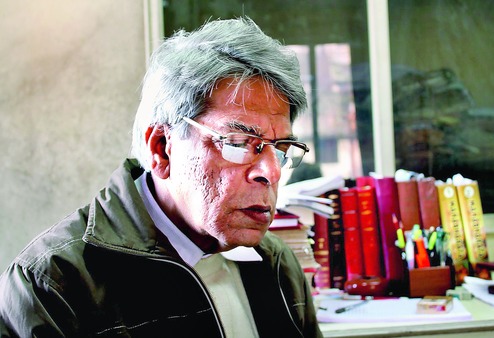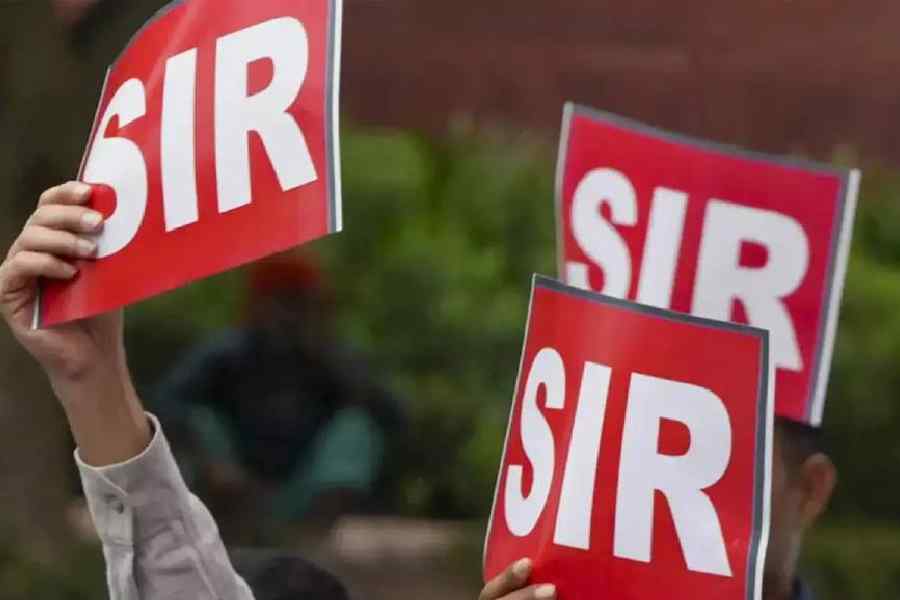

Let's begin," says the man sitting on the other side of the coffee table and starts shooting, "Do you know how Jarasandha died?" It is a rain-soaked August evening. We are at a coffee shop in south Calcutta and my quizmaster is Nrisingha Prasad Bhaduri, a Sanskrit scholar, Indologist and this year's Sahitya Akademi award winner for the Bengali prose work, Mahabharater Ashtadashi - an analysis of 18 key female characters of the Mahabharat.
The 68-year-old is relentless, "How did Jarasandha die?"
Didn't Bhim kill him?
Bhaduri sips at his coffee and asks again - "How?"
In a wrestling match. Acting upon Krishna's instructions. Bhim split Jarasandha's body into two parts and tossed each part in opposite directions.
The Indologist mutters a mild approval but his gaze remains floorwards and he seems to be suppressing a chuckle. Soon enough, however, he resumes the questioning. "So, how would you describe Karna's character?"
****
This role reversal of interviewer and interviewee is Bhaduri's idea. We are meeting to discuss his Herculean project of translating Vyasa's Mahabharat into Bengali - a literal translation of all 1,00,000 Sankskrit verses or shlokas of the epic attributed to Vyasa. Bhaduri has decided to ask the questions.
The project that started this April is supposed to assume final shape in another five years. In the meantime, individual shlokas are being uploaded on the site - dgfoundation.in/mahabharat - as and when they are being translated.
Says Bhaduri, "Along with the literal translation, there will be micro-encyclopaedic notes. But, no interpretation."
He adds, "You see, for ages it is the interpretation, actually the 'wrong' interpretation of the text that has been creating and spreading all sorts of confusion and misconceptions."
Could he elaborate on the "misconceptions"? Of course, but first he needs a response to the question he has posed - a description of Karna.
This one is a no-brainer. Karna was a great warrior and a tragic hero known for his charitable nature.
"Excellent," says Bhaduri and slips in another question. Could I elaborate on the charity bit? Indeed. Karna never turned away anyone who approached him for help.
This time there are no suppressed chuckles. Instead, my response works like a pin-prick bursting Bhaduri's carefully contained composure. Seismic with laughter, he says, "Both answers are wrong. Not that I blame you for it. Almost everyone offers the same answers. Now, had they read the actual text, the answers would have been different. I've taken up this project to clear these very misconceptions."
According to Bhaduri, Jarasandha's killing has been described in the Mahabharat's Sabha Parva. The verse, " Bhramayitya shatagunang janubhyam bharatarshava/ Babhanja prishthang sankhipya nishpidya binanad cha" (2.24.6 of the Chitrashala Press edition), means Bhim killed Jarasandha by breaking his janu-prishtha or knee and backbone. The over-dramatisation crept in, possibly, in the translated version of the epic by the sixteenth century Bengali poet, Kashiram Das.
He also points out that in the Vana Parva, Karna vows he will not let anyone return from his door empty-handed until he kills Arjun. " Padau na dhabaye tabad jabanna-nihatorjunah/ Kilalajang na khadeyang charishye chasurbratam nasteeti naiba bakshyami jachito jena kenachit (3.212.15/16 of Haridas Siddhantabagish's translated version) is the actual quote. "It means," Bhaduri says, "Karna vowed that he wouldn't wash his feet, eat meat, drink liquor or return anyone empty-handed from his door until he killed Arjun."
The time span between this vow-taking and the final battle between Arjun and Karna was one-and-a-half-years, approximately. "So, it is only for this particular time that Karna turned charitable - not for his entire life," Bhaduri says.
****
Of late, the vigilantes have been on an overdrive - no beef eat-ing, love jihad and so on. They back their unwarranted acts of moral and societal guardianship with quotations from the shastras or scriptures. "Which shastra are they referring to?" thunders Bhaduri. "Is it shastra or an interpolation or mere selective quoting?"
Bhaduri cannot seem to emphasise enough the problematic nature of the periphrastic translations of the Sanskrit texts. The over-dramatisations might have appealed to readers and enhanced the poetic impact, but they were actually deviations from the original text.
According to him, the Sanskrit editions of the Mahabharat, by and large, are consistent in their representations of the constituent events. And that is why his project seeks to inculcate inputs from almost all available Sanskrit editions from all over the country.
"My aim is to make an 'uncut' version of the Mahabharat. For this, I will take into consideration a whole lot of Sanskrit editions, ranging from the Kumbakonam edition of the text published from Bombay to the one that came out from Pune, a Chitrashala press publication. Once all these are collated, all gaps will be plugged."
Bhaduri's touchstones would be 19th century Sanskrit scholar Panchanan Tarkaratna's works and 20th century Bengali scholar Haridas Siddhantabagish's translated version.
But almost all the olden Bengali translations are riddled with archaic usage. These come in the way of a clear understanding. And it is to tackle these that he is including the "micro-encyclopaedic notes". He explains, "For instance, in the first shloka of the Mahabharat, we find a word ' kulapate'. It qualifies saint Shaunak by saying 'Shaunakasya kulapate'. Readers may have known Shaunak the sage, but what does kulapate stand for? It means chieftain of a sect or clan. These annotations are important and will be made available to the reader."
In addition, the verses and half-verses will all be indexed so that shlokas can be easily found.
***
A four-member team, headed by Bhaduri, has ventured into this project. Bhaduri says that such an enormous amount of academic labour is involved that there is no scope for him to say, "I have done a good day's work and tomorrow is Sunday."
His sense of urgency comes through. "I believe I have some responsibility towards this generation - at least to provide them with lucid and authentic information on our epic. I'm doing just that," he says.
The "responsibility" assumes significance in the light of the recent incidents of religious fanaticism that have gripped civil society. Bhaduri says, "Casteism - the discrimination on the grounds of caste - has never been something that is dictated by an individual's birth, at least if you want to go by the Mahabharat. In the Gita, Krishna says - ' Chaturvarna maya srishtya gunakarmo bibhagayo...' The Lord has created the four divisions of human society according to their 'gunakarmo' - quality and assigned task - and definitely not by birth. But in reality what do we do?"
The expert feels that a thorough reading of the shastras would broaden people's minds. He says: "Remember, Vidyasagar [the 19th century reformist] had to cite the Parasara Samhita [a Vedic treatise on the code of societal laws or norms] in order to establish that widow remarriage was actually approved in Hindu shastra."
But what if the original Sanskrit texts were alloyed with interpolation? That is a possibility Bhaduri does not even begin to deny. He agrees that composition of an epic is a continual process of interpolation, addition, as well as alteration. What he seems to be saying, however, is that there are interpolations and there are interpolations, and one must be discerning enough to separate the wheat from the chaff.
Of late, there has been some talk on how the Ramayan's Uttar Kanda is an interpolation. Possible reason: because it allegedly shows Ram in poor light. Says Bhaduri, "Now, you tell me - when was Uttar Kanda added to the Ramayan? We have Bhasa (not Vyasa), a first century poet and playwright, whose Pratima (a play) incorporates events from the Uttar Kanda. Then we have Kalidas's Raghuvansham, a fourth century epic poem, which also refers to events from Uttar Kanda. In effect, the text or alleged interpolation has been with us for at least 2,000 years. We can't, suddenly, call it an interpolation only because it does not match our imagination of an epic hero."
It's time we started reading between the lines. Says Bhaduri, "Know the text and you will know all."










